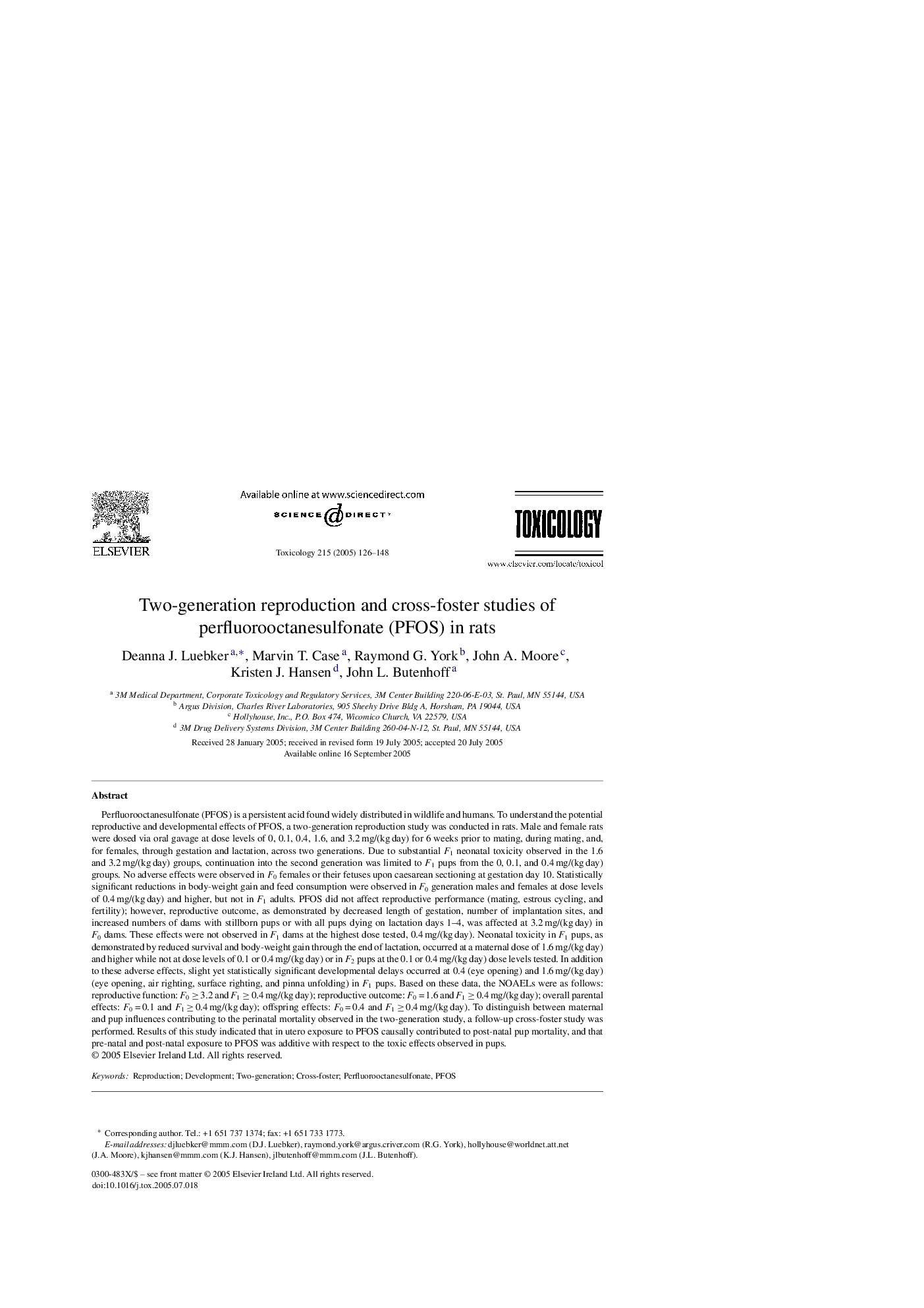| کد مقاله | کد نشریه | سال انتشار | مقاله انگلیسی | نسخه تمام متن |
|---|---|---|---|---|
| 9034526 | 1562441 | 2005 | 23 صفحه PDF | دانلود رایگان |
عنوان انگلیسی مقاله ISI
Two-generation reproduction and cross-foster studies of perfluorooctanesulfonate (PFOS) in rats
دانلود مقاله + سفارش ترجمه
دانلود مقاله ISI انگلیسی
رایگان برای ایرانیان
موضوعات مرتبط
علوم زیستی و بیوفناوری
علوم محیط زیست
بهداشت، سم شناسی و جهش زایی
پیش نمایش صفحه اول مقاله

چکیده انگلیسی
Perfluorooctanesulfonate (PFOS) is a persistent acid found widely distributed in wildlife and humans. To understand the potential reproductive and developmental effects of PFOS, a two-generation reproduction study was conducted in rats. Male and female rats were dosed via oral gavage at dose levels of 0, 0.1, 0.4, 1.6, and 3.2 mg/(kg day) for 6 weeks prior to mating, during mating, and, for females, through gestation and lactation, across two generations. Due to substantial F1 neonatal toxicity observed in the 1.6 and 3.2 mg/(kg day) groups, continuation into the second generation was limited to F1 pups from the 0, 0.1, and 0.4 mg/(kg day) groups. No adverse effects were observed in F0 females or their fetuses upon caesarean sectioning at gestation day 10. Statistically significant reductions in body-weight gain and feed consumption were observed in F0 generation males and females at dose levels of 0.4 mg/(kg day) and higher, but not in F1 adults. PFOS did not affect reproductive performance (mating, estrous cycling, and fertility); however, reproductive outcome, as demonstrated by decreased length of gestation, number of implantation sites, and increased numbers of dams with stillborn pups or with all pups dying on lactation days 1-4, was affected at 3.2 mg/(kg day) in F0 dams. These effects were not observed in F1 dams at the highest dose tested, 0.4 mg/(kg day). Neonatal toxicity in F1 pups, as demonstrated by reduced survival and body-weight gain through the end of lactation, occurred at a maternal dose of 1.6 mg/(kg day) and higher while not at dose levels of 0.1 or 0.4 mg/(kg day) or in F2 pups at the 0.1 or 0.4 mg/(kg day) dose levels tested. In addition to these adverse effects, slight yet statistically significant developmental delays occurred at 0.4 (eye opening) and 1.6 mg/(kg day) (eye opening, air righting, surface righting, and pinna unfolding) in F1 pups. Based on these data, the NOAELs were as follows: reproductive function: F0 â¥Â 3.2 and F1 â¥Â 0.4 mg/(kg day); reproductive outcome: F0 = 1.6 and F1 â¥Â 0.4 mg/(kg day); overall parental effects: F0 = 0.1 and F1 â¥Â 0.4 mg/(kg day); offspring effects: F0 = 0.4 and F1 â¥Â 0.4 mg/(kg day). To distinguish between maternal and pup influences contributing to the perinatal mortality observed in the two-generation study, a follow-up cross-foster study was performed. Results of this study indicated that in utero exposure to PFOS causally contributed to post-natal pup mortality, and that pre-natal and post-natal exposure to PFOS was additive with respect to the toxic effects observed in pups.
ناشر
Database: Elsevier - ScienceDirect (ساینس دایرکت)
Journal: Toxicology - Volume 215, Issues 1â2, 5 November 2005, Pages 126-148
Journal: Toxicology - Volume 215, Issues 1â2, 5 November 2005, Pages 126-148
نویسندگان
Deanna J. Luebker, Marvin T. Case, Raymond G. York, John A. Moore, Kristen J. Hansen, John L. Butenhoff,